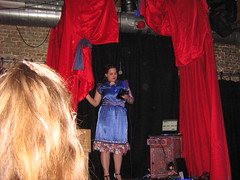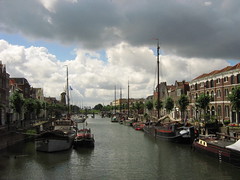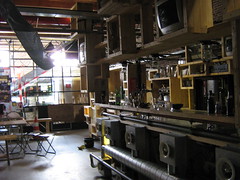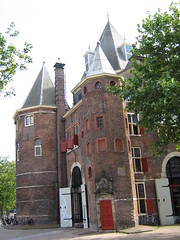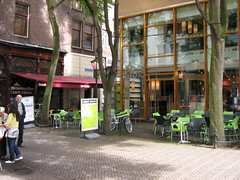OK, this is Nancy’s performance which I mentioned already. I can imagine a lot of bands or performers that would really like to have something that is not only wireless, but responds to gestures, to position, rather than being just some keypad. And Nancy has personalized the interface for herself, but that also could change, which I think might be even more interesting to performers, to use a tool that really matches their style. Also, Nancy made these tools herself with (I think) just a little help with programming, which means that other musicians and performers could make their own tools as well, without needing an a degree in software or electrical engineering, which to me seems a very liberating development.
Voorhaven, clouded over
Even on cloudy days, it looks dramatic. Of course this stretch is essentially the historical street left in the city, so any post card that shows and old building is almost certain to have been shot on this street!
A lovely place to walk, and has several cafes, antique stores, and the industrial scrap shop from which the students got a lot of stuff for the show.
Worm bar
Here is the bar inside Worm; the whole thing is constructed inside a historical building, the structure which couldn’t be touched. So, everything is attached to a free standing metal framework and is all made of industrial scrap from the harbor. It’s amazing. About 4-5 projects were set up in this room later in the day, and they fit in really well.
Ok, back from dinner and more on the party at Worm. I have to say it was a blast, not least because I haven’t had the chance to go out dancing like that in years. First one of th Piet Zwart graduates did a performance, which was really cool. —Nancy Mauro-Flude did a final project:
‘Paraphernalia’ consists of self-built controllers for audio/dance performances that free performers from operating laptops on stage, giving them back their gestural mobility, and allowing both a technical and artistic feedback between music, vocals, dance and technology. (Realized with joystick interfaces, analog motion sensors and modified gamepads in conjunction with the real-time signal processing software Pure Data.)
She did a performance singing with these tools and it was a lot of fun. After that, there was a DJ for awhile and people danced hard, including both the PZI MD staff and the students–how many grad students celebrate with their faculty that way? I drank rather a lot of Budels Honig Bier, but not too much to be ok today.
I got to bed quite late, but got up in time to shop for souvenirs and take a Spido boat tour of the harbor–that was really cool and I will post some pictures from the whole weekend soon. I think tomorrow I might finally have time to catch up on more conference reporting…
After a busy few days, here I am again. The conference in Utrecht was mixed; I saw several interesting key note speakers, including Katherine Hayles and Joanna Zylinska, and I met some very nice, interesting people, including Renee Turner, an artist from Geuzen.org, Yasco Horsman, from the University of Leiden, and Manuela Rossini from the University of Amsterdam. I think though that at both this conference and at New Network Theory, many of the panels would have been better as roundtable discussions.
Let’s see, I’ll comment on the best of the talks tomorrow when I’m not so tired. I still feel pretty washed out because I spent most of yesterday (and last night) at the Piet Zwart Media Design graduation, final show, and opening/graduation party. That was all at Worm, a music/art/cultural space here in Delfshaven. I’m interviewing the director, Hajo Doorn tomorrow, about the Worm is organized. The graduation was really great. Worm is a great space for the students to install their projects, and the projects themselves were quite interesting. Kristina, one of the tutors, made a speech full of advice, and then Florian spoke, starting with the hope that they didn’t regret working with him, since he took over as Course Director half way through their program and had been a hard-ass. It was a startlingly candid statement for a graduation speech! The nicest thing though was how personal the whole event was. There were only nine students graduating so each was individually addressed–maybe it was too personal for some of the students who seemed really embarrassed when Florian made (positive) comments about each of their work and personalities. Then we had some lunch, and then Florian gave another general speech opening the show, and then we all hung around for a few more hours. I talked to several students about their projects; one of my favorites was by Andrea Fiore, called Cookie Census. This project is:
A software platform for the collaborative tracking and annotation of web cookies. Considering them identifiers and actuators of user control, the Cookie Census provides a distributed system for their survey and annotation. (Realized as a combination of a web browser plugin, MySQL database and web site.)
Finally around 7 or 8 I went to dinner with Florian, Josephine Bosma, and her daughter Jasmin. Because the good place we wanted to go was too crowded, we instead had some Roti, which was also good, but my duck had a ridiculous number of little broken bones in it. Anyway, Josephine is an interesting person; I’ve enjoyed reading her articles about digital media, and the art/theory scene in Europe and was happy to meet her in person. Jasmin is also really cool–I hope my girls are as much so when they reach her age.
So, we went back to Worm and the party opened at 9pm. I looked at more projects and had a chance to talk again at length with Mirko Schaefer whom I had seen and briefly met at the Network theory conference. he’s a really nice guy who does a lot of research about open source communities, and is finishing up his dissertation at Utrecht University where he’s a lecturer. Now I’m going to dinner, so I’ll write more later. –and damn, the blockquote has messed up my spacing.
De Waag
And here is de Waag building, originally constructed in the 13th century, now home to the Society for Old and New Media, and a pretty nice cafe.
at de Waag Society for Old and New Media
Today I went to visit de Waag and met with Bart Tunnissen and Sher Doruff who are finance manager and head of the research dissemination program, respectively. This was an interesting meeting because de Waag takes a very different approach from either Piet Zwart or V2; though they conduct research they are not academic and they have a very broad target audience, and have many community connections. Though they have not been around for so very long–11 years, they have become very important in shaping the agenda for the “creative industry” in the Netherlands, in part it seems because their founder and director general, Marleen Stikker earlier created the “Digital City” in Amsterdam, and so has been a real pioneer in this area. Also, like V2_, they have established a reputation for good practice and innovation.
So where to begin, well Bart gave a brief run-through on the history, but that’s on the website so I won’t repeat it. Mostly they talked about how they go about connecting with the community, choosing projects and carrying them out, and then some about funding and those challenges. They get 6-10 proposals per week and make a first pass through them to look for those that will a)match one of the 4 domains and 6 programs they have chosen to focus on, and b) appear to have a good chance of really succeeding–I’m not sure how they measure that though, except it may mean they can create new knowledge that eventually leads to a new product heading to market.
Bringing products to market seems to be one of the bigger challenges for de Waag, because the Netherlands doesn’t have so many venture capitalist types (comparatively). –After the tech crash I’m not sure how easy it is anywhere, really. This is one way the are really different from PZI and V2_ though, in having this as a goal. But they also emphasized that you can’t start working with a partner and have profit as a goal, or why would that partner trust your intentions? Intellectual Property issues are thus a double concern for them, both in theory but also in their practice. –In fact I think this must be quite tricky and I will have to email some follow up questions because de Waag really emphasizes what they call a “user as designer” approach, so if something does eventually end up being developed for the market, then what? Who is the designer and to be blunt, who profits? I admire the approach for its Freirean quality, and I think it certainly would strengthen the commitment from community groups to a project, and strengthen ties between them and de Waag, besides of course being more educational for everyone. I appreciate though how balancing different concerns takes real skill.
Well, there is more to say, but today Remediating Lit. starts and I have to get ready for the trip to Utrecht.
On Oude Binneweg
I’ve walked up and down this street a couple of times, but haven’t yet had a chance to really explore the shops there–this section has only pedestrian traffic, which I love. Yesterday I at least made it into a cheese shop and it was amazing. The light on the street was good too, so even though I was rushing, I couldn’t resist a few pictures. This was taken around 5:30, so there aren’t so many people and many shops are closing– a lot aren’t even open on Monday and those that are close early. This city is SO not aimed for tourists! It’s great to be somewhere that isn’t all designed to extract the maximum in tourist dollars, but instead is focused on the people who live there.
What We Expect of Students
I started this last night, but now it’s morning…
I’ve just returned from another set of student exhibitions connected with Willem de Kooning and with Piet Zwart, the BA-Fine Arts graduation show from WdKA and the first-year MA-Fine Arts from PZI. I must say I didn’t think the first year MA show looked much better than the BA show, and didn’t even come close to the Media Design First Year MA show. It was almost all just formalist stuff, very little evidence of reflection on the media, and even though both exhibitions were not in formal gallery space, they looked as if that’s where they belonged, in a white cube.
Also, one of the Media Design MA students was at the BA show, helping out. She happens to not yet be ready for her show that opens on Saturday, so why she was out at this other event…Students!
Tomorrow (I mean today, now) I meet with people from De Waag Society for Old and New Media, so I’ll save more comments until after that.
Alex Adriaansen at V2_
This afternoon I had a lengthy meeting with Alex Adriaansen, director at V2_ ; he could not have been more generous with his time or forthcoming with his views about the context for New Media studies in the Netherlands or the challenges they face. So I will note it all down before I forget!
First, V2_ has been around for 25 years and that means that by now they have established a reputation as doing interesting, edgy things and also having good practices. Alex emphasized how important it was to them to be truly interdisciplinary themselves, and this brings it’s own challenges because scientists have one way of doing things and, people concerned with business have another, and artists still another, and so on. But he felt this was something they had succeeded in working out over the years, and now these other groups respect their way of doing things.
Another characteristic of the Dutch context is the focus on projects rather than on structural funding schemes for the long term. Alex attributes this to politicians and business people tending to take a short view that always judges success by some concrete result, rather than on what is learned or on long-term possibilities. The problem for V2_, (or any organisation, because I see this in the US as well) is that you have to always follow whatever trend the funding agency is hot for, which means first that you may not be able to really follow through on ideas that need more time, and, perhaps a greater problem, you can get caught up iin the hype so that you lose your critical perspective. I’ve heard this from Florian at Piet Zwart as well, and I will be sure to check on it at De Waag tomorrow.
But Alex felt that they were navigating these challenges successfully. I think V2_ audience may be less prone to falling for hype as well, because most of their programs are aimed at the “creative class” meaning artists, designers, theoreticians, etc. Except for the DEAF Festival, they aren’t very concerned with reaching a wide audience. However, they have decided to strengthen their ties to some educational institutions. They have a pretty strong connection to Piet Zwart MDMA already, and now they are pursuing a PhD programs with some universities (he didn’t say which). I think that sounds like a great idea, and it makes me wish I had time to take on another degree!
The biggest challenge Alex sees ahead for V2_ is reorganizing itself so that it can on the one hand strengthen it’s artistic focus, but on the other build on the more “practical” possibilities suggested by their research. So I look forward to seeing what happens in the next year. –Or rather the next four, as these things go in the Netherlands.
In addition to talking about V2_, we also talked about the program under development at my school, CSU Stanislaus, and the challenges we face in being rather isolated from any big cities or cultural institutions. He suggested looking at the IAMAS program in Japan; from their website, IAMAS is:
AMAS consists of two schools: the Institute of Advanced Media Arts and Sciences and the International Academy of Media Arts and Sciences. The Institute is solely a graduate school (for obtaining a Masters Degree) and has one faculty and one course, namely Media Creations. There are 20 students in each year of the course. The Academy is a vocational college accepting 30 students each year who must have at least graduated from high school.
That sounds like an interesting program to investigate.
In addition to thanking Alex for his time, and for sharing of the electronic proceedings of DEAF with me, I also have to thank him for being so gracious about my being almost an hour late! On my way there I got completely loast in the tram system and every time I thought I figured it out, I went even more wrong. Finally I just took the Metro, which I seem to understand better. Lucky for me I had already purchased an OV-chipkaart, which iis a smart card for the metro, buses, and trams. My strippenkaart would never have lasted through that maze, and then I would have had to search for a shop to buy one… But anyway, all’s well that ends well.
I may edit this later if I realize I’ve forgotten something.
